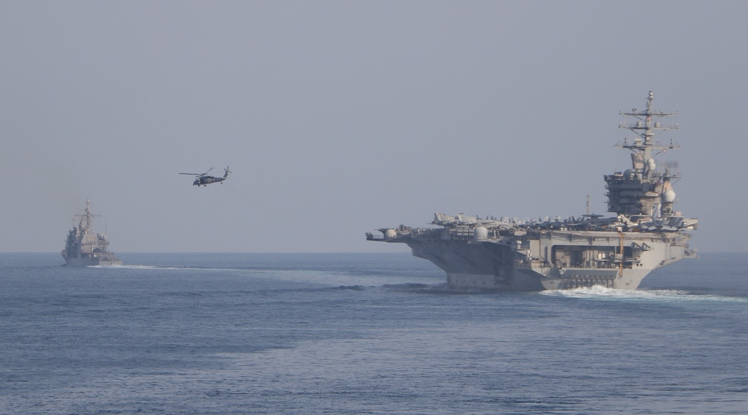 Eisenhower Carrier Strike Group in the Strait of Hormuz (2023) | Image Credit: U.S. Central Command
Eisenhower Carrier Strike Group in the Strait of Hormuz (2023) | Image Credit: U.S. Central Command
Can The U.S. Still Pivot Away From The Middle East?
“The Middle East region is quieter today than it has been in two decades.” These were the words of U.S. National Security Adviser Jake Sullivan eight days before Hamas’s attack on Israel. Since then, four fronts have erupted: Gaza, the Israel-Lebanon border, Yemen and the Red Sea, and Iraq and Syria. After an Iranian-backed militia in Iraq killed three U.S. service members, fears of a direct confrontation between the United States and Iran reached new heights. Now, U.S. Secretary of State Antony Blinken is warning that the Middle East is at its most volatile since 1973. What a difference four months can make.
After decades of a sustained footprint, the United States remains bogged down in the Middle East. Four successive American presidents ventured to pivot from the Middle East to Asia to confront an ascendant China; four successive American presidents have been unable to do so. Civil wars, terrorism, and Iranian destabilization have demanded U.S. intervention. Now, the region threatens to unravel. Can the U.S. still pivot from the region, or must it resign itself to the notion that the Middle East’s problems are America’s problems?
A strategic pivot is possible if the U.S. acknowledges the Middle East’s enduring importance to American national security, and therefore lays a proper security foundation rooted in regional cooperation.
First, Washington must recognize that a pivot need not be a withdrawal. Despite its diminished importance for American energy needs, the Middle East remains strategically significant. Former U.S. Secretary of Defense Robert Gates pointed out that “historically, the Middle East is important not just for oil and gas but because of its location, geography, and shipping lanes.” 12% of global trade, including 30% of global container traffic, transits the Red Sea, which is under bombardment by the Houthis. In recent years, Iran has threatened to blockade the Strait of Hormuz, a chokepoint for 20% of the world’s oil and 20% of the world’s liquified natural gas, a move that would debilitate the global economy. An American presence in the Middle East is thus necessary to secure international trade, security, and freedom of the seas.
Additionally, terrorism in the Middle East is still a cause for concern. If the U.S. were to pull out of the region without a coherent counterterrorism strategy, the world could witness the resurgence of ISIS or other like-minded organizations. Moreover, in the event of a decreased American presence, Iranian destabilization efforts could proliferate unabated.
To combat these phenomena, the U.S. must anchor Middle Eastern security in normalizing relations between Israel and Saudi Arabia, thereby constructing a more stable environment for a U.S. pivot from the region.
Prior to October 7, Israel and Saudi Arabia were closer than ever before to normalizing relations, but with the war in Gaza, this now appears out of reach. Despite this, American efforts to broker the landmark deal have proceeded.
Jerusalem and Riyadh share a mutual interest in confronting terrorism. For Israel, terrorism has been an existential threat for decades. Saudi Arabia, despite its history of generating terrorists, craves regional stability as it tries to achieve its ambitious economic diversification goals by 2030. Both countries are also aligned in their opposition to Iran. From Iran’s perspective, Israel represents a Western imperialist outpost standing in the way of its Pan-Islamic aspirations, while Saudi Arabia, aside from its divergent religious interpretations, represents a roadblock to Iranian regional hegemony. The regime’s revolutionary origins and exportation of chaos contradict Riyadh’s quest for regional and monarchical stability. Saudi Arabia and Israel are two of the most powerful countries in the Middle East; backed by American economic, technological, and military support, these two states can head a regional alliance that promotes security and economic development over perpetual conflict.
The Middle East is not as important for U.S. interests as it once was, however, time and again, it has showed us the dangers of ignoring it. If the U.S. endeavors to shift its focus to other theaters, primarily the Indo-Pacific, it will first need to ensure that its regional partners, which it has spent decades funding, equipping, and supporting, can uphold regional security. With no end in sight to the ongoing turmoil in the Middle East, it is convenient to dismiss a U.S. pivot as wishful thinking. However, there is a path forward, and now is the time to start thinking about a new phase of American engagement in the Middle East.





